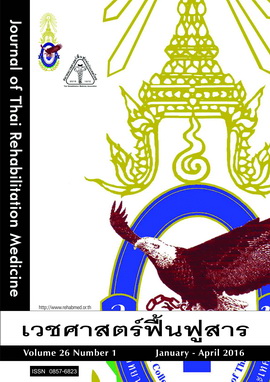กลุ่มกล้ามเนื้อและจำนวนการตรวจคลื่นไฟฟ้ากล้ามเนื้อในการ ระบุโรครากประสาทส่วนเอวร่วมใต้กระเบนเหน็บ
Number of Muscle Groups Study for Identifying Lumbosacral Radiculopathy
Keywords:
number of muscles, electromyography, lumbosacral radiculopathy, paraspinal muscleAbstract
ABSTRACT
Objectives: To determine the optimal electromyographic screening examination that ensures identification of the lumbosacral radiculopathy (LSR).
Study design: Retrospective descriptive study.
Setting: Electrodiagnostic laboratory at Rehabilitation Medicine Department of Phramongkutklao Hospital.
Subjects: The patients with electrodiagnostically comfirmed LSR from January 2008 – December 2012.
Methods: There were 186 patients with 224 electrodiagnostically confirmed LSR was conducted to determine which muscles and how many muscles were required to identify a lumbosacral radiculopathy. All lumbosacral radiculopathies showed abnormal spontaneous activity in at least two muscles innervated by the same nerve root level but different peripheral nerves. All cases categorized by radiculopathy level and most frequently abnormal individual muscles were combined into different type of muscle groups. Each type of muscle groups included paraspinal muscle. The percentage of identifying a radiculopathy in each muscle group was the number of revealing abnormal electromyographic findings in one or more muscles in the group divided by the total number of radiculopathies.
Results: Among all electrodiagnostic data of LSR, the L5-S1 radiculopathy was the most common diagnosis (33.5%).The paraspinal muscle alone identified 89.5% of lumbosacral radiculopathies. When paraspinal muscle was one of the examined muscles, four muscles identified 78.57-97.32 %, five muscles identified 80.80-98.66 %, six muscles identified 84.82-99.55%, seven muscles identified 91.96-99.55% and eight to nine muscles identified 97.32-99.55% of lumbosacral radiculopathies
Conclusion: Paraspinal muscle should be included in electromyographic study to determine lumbosacral radiculopathy. Six muscles including paraspinal muscle yield high identification rates of abnormal spontaneous activities. There is no improvement in identification if the number of muscle studied is increased.
References
2. Bogduk N. On the definitions and physiology of back pain, referred pain, and radicular pain. Pain 2009; 147: 17-9.
3. Lipetz JS, editor. Pathophysiology of inflammatory, degenerative, and compressive radiculopathy. Philadelphia: W.B. Saunders; 2002.
4. Barr K, Electrodianosis of Lumbar Radiculopathy. Phys Med Rhabil Clin N Am 2013;24:79-91.
5. Ter Meulen BC, Rath JJ. Motor radiculopathy caused by varicella zoster virus without skin lesions (‘zoster sine herpete’). Clin Neurol Neurosurg. 2010;112:933.
6. Weishaupt D, Zanetti M, Hodler J, et al. MR imaging of the lumbar spine: preva-lence of intervertebral disk extrusion and sequestration, nerve root compression, end plate abnormalities, and osteoarthritis of the facet joints in asymptomatic volunteers. Radiology. 1998;209:661–6.
7. Dillingham TR, editor. Electrodiagnostic approach to patients with suspected radiculopathy. Philadelphia: W.B. Saunders; 2002.
8. Spengler DM, Freeman CW. Patient selection for lumbar disectomy: an objective approach. Spine. 1979;4:129–34.
9. Spengler DM, Ouellette EA, Battie M, Zeh J. Elective discectomy for herniation of a lumbar disc: additional experience with an objective method. J Bone Joint Surg Am. 1990;72A:230–7.
10. Lauder TD, Dillingham TR, Huston CW, Chang AS, Belandres PV. Lumbosacral radiculopathy screen: optimizing the number of muscles studies. Am J Phys Med Rehabil. 1994;73:394–402.
11. Dillingham TR, Lauder TD, Andary M, Kumar S, Pezzin LE, Stephens RT, et al. Identifying lumbosacral radiculopathies: an optimal electromyographic screen. Am J Phys Med Rehabil. 2000;79:496–503.
12. Maclean IC. Acute radiculopathy in EMG and clinical meurophysiology: a high intensity review. Rehabilitation Institute of Chicago, Northwestern University Medical Scool, April 3-6,1989.
13. Gough JG, Koepke GH. Electromyographic determination of motor root levels in erector spinae muscles. Arch Phys Med Rehabil. 1966;47:9 –11.
14. Johnson EW, Melvin JL: Value of electromyography in lumbar radiculopathy. Arch Phys Med Rehabil. 1971;52:239-243.
15. Tsao BE, Levin KH, Bodner RA. Comparison of surgical and electrodiagnostic findings in single root lumbosacral radiculopathies. Muscle Nerve. 2003;27:60-4.
16. Burakgazi AZ, Kelly JJ, Richardson P. The electrodiagnostic sensitivity of proximal lower extremity muscles in the diagnosis of L5 radiculopathy. Muscle Nerve. 2012;45:891-3.
17. Dumitru D, Amato AA, Zwarts M, eds. Electrodiagnostic Medicine, 2nd ed. Philadelphia, PA: Hanley & Belfus; 2002; 722.






